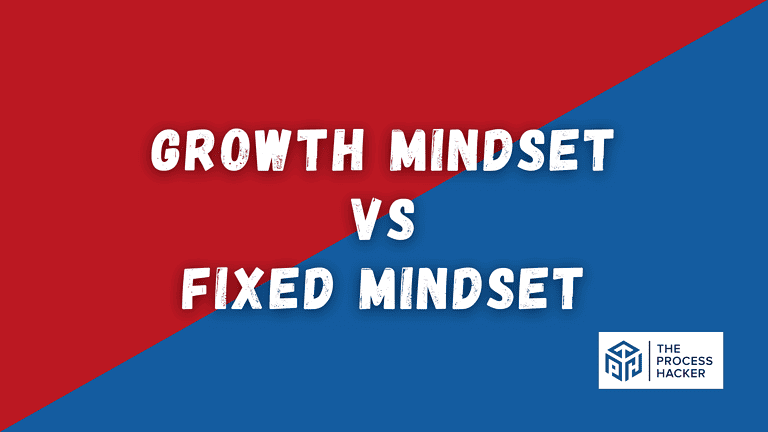MyVision Clarifier: Define Your Vision
The more clarity you have, the more likely you will succeed. Clarify your business vision by answering 8 questions in the MyVision Clarifier.
Are you ready to launch your business? Before launching a company, you need to make sure you have total clarity for your vision. In Entrepreneurial Leap (book summary), Gino Wickman helps you clarify your business vision using his free tool, the MyVision Clarifier.
You need to document your vision as this will help you clarify and ultimately be more successful. The MyVision Clarifier enables you to organize and formulate the eight vital aspects of your vision that will confirm your idea and help you get started:
- My Passion: Why? What am I passionate about?
- My Customer’s Needs: What need (or want) am I filling for my customer/client?
- My Ideal Customer: Who is my ideal customer?
- My Pricing Structure: What’s the pricing structure for my product or service?
- 10-Year Goal: What’s the number one most important goal to accomplish in ten years?
- 3-Year Plan: What do I want to accomplish in the first three years?
- 1-Year Plan: What do I want to accomplish in the first year?
- 90-Day Plan: What are the most important things to accomplish in the next ninety days?
If you prefer a paper or digital copy, the MyVision Clarifier is freely available for download here. Throughout this post, I will use my own company, The Process Hacker, as an example for the eight questions presented.
My Passion
What am I passionate about? Why am I doing this?
In his book, Start With Why, Simon Sinek says, “People don’t buy what you do; they buy why you do it.” So if you want to inspire others to buy your products and services, you need to communicate why you and your business are doing what you are doing.
In addition, you need to enjoy what you are doing and cultivate a passion for your purpose and work:
Passion – an intense desire or enthusiasm for something
Most companies know what they do and tend to communicate this first to their customers. This action seems logical; however, the strong why can be emotionally powerful in getting your customers to buy into you and your business.
You can establish a set of core values that will guide your passion and set expectations for yourself and your business. From there, your why or the purpose, cause, or passion of your business should be written down in a short phrase (preferably three to seven words) that is simple, bold, and heartfelt.
In MyVision Clarifier, my passion is as follows:
My Passion is:
Helping people optimize productivity and achieve massive goals.
My Customer’s Needs
What need (or want) am I filling for my customer/client?
You can have a fantastic product or service, but they will not buy it if people don’t think they need it. So to be an entrepreneur, you need to understand your customer’s needs (or wants), see them as an opportunity, and fulfill them for profit:
Customer’s Needs – the reasons that prompt a customer to buy a product or service
The customer’s needs stem from problems in their own life that you can solve. These are common customer needs that exist:
- Product: functionality, price, convivence, experience, design, reliability, performance, efficiency, and compatibility
- Service: empathy, fairness, transparency, control, option, information, and accessibility
You can identify customers’ needs by soliciting feedback on current offers or conducting surveys, interviews, and focus groups. Then after understanding the needs well, you can design the solution of the product or service that solves your customer’s pain points.
In MyVision Clarifier, my customer’s needs are as follows:
My Customer’s Needs are:
- Stop wasting time to have more time for family, friends, and hobbies.
- Get more done to impress their boss and team to earn a promotion or higher salary.
- Make more money to better provide for their family and buy what they want.
My Ideal Customer
Who is my ideal customer?
To build a business, you need to reach the right customers with the appropriate needs to buy your products and services. And you can’t afford to target everyone. Your marketing efforts to be effective and start with clarifying and identifying your ideal customer:
Ideal Customer – the targeted people that are willing to pay for your product or service:
- Demographic – the characteristics of who they are, including age, race, sex, ethnicity, education, income, occupation, etc.
- Geographic – the physical and virtual location of where they are
- Psychological – the psychology of what they are, including personality, attitudes, values, emotions, interests, behavior, lifestyle, etc.
Be very specific when clarifying each part of the ideal customer, as a smaller entrepreneur can be more effective than a larger company by targeting a niche market. Also, your ideal customer can help inform how you design, package, and distribute your good or services. Therefore, it is helpful to create an avatar to describe your ideal customer:
Avatar – a detailed expiration and description of your target customer and their lives that will help you get into their mind, understand their wants, and tailor your marketing to them
When you can filter down to your ideal customer, you can target your marketing to the specific media to reach them, such as email, social media, or snail mail. Then, create a list of prospects for your sales and marketing efforts to target.
In MyVision Clarifier, my ideal customer is as follows:
My Ideal Customer is:
- Demographic: Engineering managers in large firms that earn $120K+ in salary
- Geographic: Located in the United States
- Psychological: Seeking help to improve their productivity and achieve major goals
My Pricing Structure
What’s the pricing structure for my product or service?
Determining what to price your offer can be challenging. When you price too low, you may not earn enough margin per unit to make a profit. Conversely, when you price too high, you may not get enough customers or sell enough volume to make a profit. To start, the pricing structure can be defined as follows:
Pricing Structure – the pricing setup for products or services, which includes your core price points and decisions regarding discounts, offers, and strategy
At its core, you should set your price based on the amount of value (or perceived value) that you provide to the customer. But, simultaneously, your price should cover the costs incurred to create or deliver that product or service.
Whatever you price your product or service, you must have clarity and confidence in it. You can set a reasonable price when you understand your ideal customer, their needs, and the market you are operating within. Here are several commonly used pricing structures:
- Flat-rate – selling the product or service to all customers at the same price
- Tiered – providing multiple levels of the product with different features
- Subscription – offering an ongoing product or service for a reoccurring fee
- Variable – altering the price of the product or service based on the current levels of supply and demand
- Bundling – offering a reduced price for a grouping of products or services that, on their own, would cost more
- Freemium – offering a basic or limited version at no cost while charging more than the premium version for extra or advanced features
- Pay-per-user – providing the product or service and pricing it per the frequency or duration of usage
- Pay-as-you-go – providing the product or service and pricing it per the number of users
In MyVision Clarifier, my pricing structure is a three-tiered approach as follows:
My Pricing Structure:
- $250 one-time for Course: This low-end product “shows you” how to implement my productivity system in your life.
- $500/month for Coaching: This mid-tier service has me coach “with you” to incorporate productivity habits specific to you.
- $2000/month for Consulting: This premium service has “done for you” components where I create a strategy, conduct research, implement processes, hire people, etc.
10-Year Goal
What’s the number one most important goal I want to accomplish in ten years?
Where do you want to be a decade from now? The most successful entrepreneurs have a habit of setting and achieving goals, especially in the long run. Using the first four parts of the MyVision Clarifier, you should establish the big-picture long-term goal for where your business will be ten years from now:
10-Year Goal – the long-range, energizing goals for your business that will help frame the shorter time-based goals for three years, one year, and quarterly
This long-term goal or BHAG (Big, Hairy, Audacious Goals) should be specific, measurable, and energizing to help steer the direction of your business. This 10-Year goal should seem so difficult that it may almost seem unachievable. BHAGs communicate passion, excitement, and energy, such that you feel like you are making an impact and contributing to a legacy.
The 10-Year Goal will help you frame the shorter time-based goals in the MyVision Clarifier. Also known as these goals. Note that your 10-Year Goal is not permanent, as you should reevaluate and evolve it as appropriate over time, especially if you are close to achieving it.
In MyVision Clarifier, my 10-Year Goal is as follows:
10-Year Goal:
To generate $2 Million in revenue and $1 Million in profit in 2032.
Short-Term MyVision Clarifier Goals
What will my business look like in the short term: three years, one year, and the next 90 days?
To ground the long-term 10-Year Plan into reality, you will look closer to the short-term and create plans for the following time intervals:
- 3-Year Plan: What do I want to accomplish in the first three years?
- 1-Year Plan: What do I want to accomplish in the first year?
- 90-Day Plan: What are the most important things or big rocks to achieve in the next 90 days?
With your mentors and peers, you should think and discuss how fast you want your business to grow and how much impact you will have. For each short-term period, you should record the following objectives:
- Due Date – the due date for your business to complete this goal
- Revenue – the amount of income generated by the sale of goods or services
- Profit – the business income remaining after the expenses are deducted from revenue
- Personal Income – the salary that you take home for your business
- Rocks – the 3-7 most important goals, such as projects to complete as well as the number of clients to serve, goods to sell, services to render, or widgets to produce
The goals given above should be SMART (Specific, Measurable, Attainable, Realistic, and Timely), such that they provide clarity and set the right expectations for you to get the work done.
In MyVision Clarifier, my 3-Year, 1-Year, and 90-day plans are as follows:
3-Year Plan:
- Due Date: 12/31/25
- Revenue: $60,000 per month
- Profit: 25% or
- Personal Income: $100,000
- Rocks:
- Coach 10 clients at $2000 per month.
- Conduct 2 productivity keynotes/workshops at $5000 per month.
- Sell at least 50 productivity courses per month at $500 each.
- Have a team of 1-3 employees that help run my business.
- Invest heavily into marketing and branding to grow the brand.
1-Year Plan:
- Due Date: 12/31/22
- Revenue: $10,000 per month
- Profit: 10%
- Personal Income: $50,000
- Rocks:
- Coach 10 clients at $1000 per month.
- Conduct 2 productivity keynotes/workshops at $2000 per engagement.
- Hire a full-time assistant to manage administrative and marketing tasks.
- Implement project management software.
- Create a video course for my productivity system.
- Get featured or write guest blogs for 2 websites per month.
90-Day Plan:
- Due Date: 3/31/22
- Revenue: $2,500 per month
- Profit: 0%
- Personal Income: $0
- Rocks:
- Coach 5 clients at $500 per month.
- Publish two 1000+ word blog posts per week.
- Interview 10 potential customers to understand pain points and get feedback
- Redesign website and copy to reach my ideal customers.
- Implement email marketing campaign upon subscriber sign-up.
- Create and schedule regular social media posts for LinkedIn, FB, and Instagram.
To create your 90-day plan, check out The 12 Week Year (book summary). Further, take massive action on your short-term goals using Grant Cardone’s 10X Rule.
Next Step: Use the MyVision Clarifier for Your Business
Once you answer these eight questions in the MyVision Clarifier, your vision for your business becomes very clear and keeps you focused on achieving it. The vision will also provide clarity for others who participate in your business, including mentors, partners, employees, and clients.
The more clarity you have in your vision, the more likely you will be successful. For more on documenting your vision, you should check out Entrepreneurial Leap (book summary) or use Gino Wickman’s free tool, the MyVision Clarifier. For more on establishing a vision for larger companies, check out Traction (book summary) by Gino Wickman.







